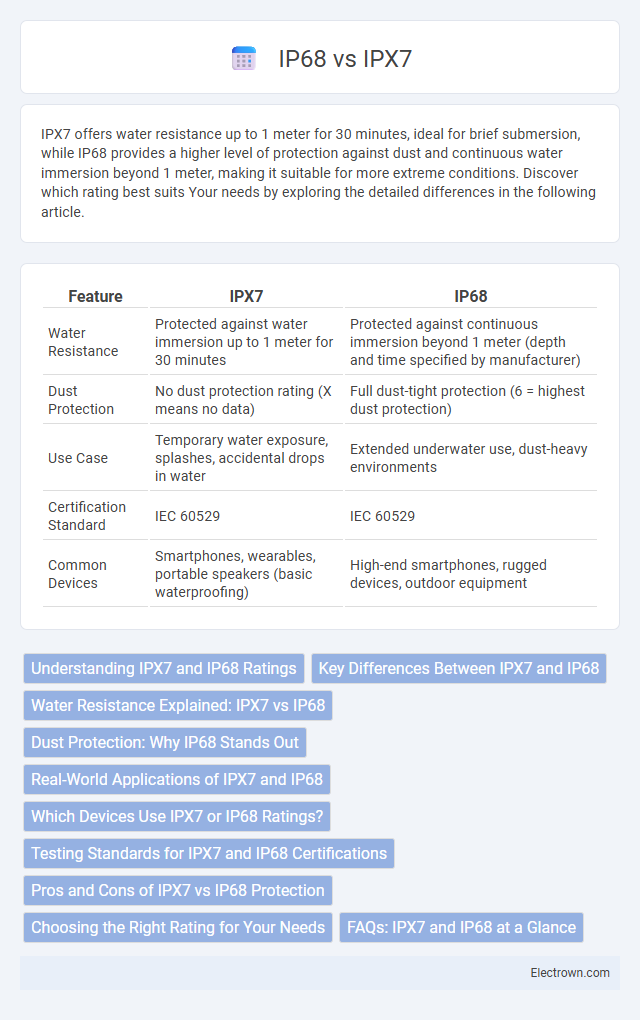IPX7 offers water resistance up to 1 meter for 30 minutes, ideal for brief submersion, while IP68 provides a higher level of protection against dust and continuous water immersion beyond 1 meter, making it suitable for more extreme conditions. Discover which rating best suits Your needs by exploring the detailed differences in the following article.
Table of Comparison
| Feature | IPX7 | IP68 |
|---|---|---|
| Water Resistance | Protected against water immersion up to 1 meter for 30 minutes | Protected against continuous immersion beyond 1 meter (depth and time specified by manufacturer) |
| Dust Protection | No dust protection rating (X means no data) | Full dust-tight protection (6 = highest dust protection) |
| Use Case | Temporary water exposure, splashes, accidental drops in water | Extended underwater use, dust-heavy environments |
| Certification Standard | IEC 60529 | IEC 60529 |
| Common Devices | Smartphones, wearables, portable speakers (basic waterproofing) | High-end smartphones, rugged devices, outdoor equipment |
Understanding IPX7 and IP68 Ratings
IPX7 rating guarantees water resistance for devices submerged up to 1 meter for 30 minutes, making it ideal for short-term water exposure. In contrast, IP68 rating offers superior protection, allowing devices to withstand continuous immersion beyond 1 meter depth, usually specified by the manufacturer. Understanding the differences between IPX7 and IP68 ratings helps consumers choose the right device based on exposure to water and environmental conditions.
Key Differences Between IPX7 and IP68
IPX7 certification guarantees waterproof protection against immersion in water up to 1 meter for 30 minutes, focusing specifically on water resistance without dust protection ratings. IP68 rating signifies full dust tightness and prolonged immersion beyond 1 meter, often specified by the manufacturer, ensuring comprehensive protection in both dust and water environments. The fundamental difference lies in IP68's combined dust and superior water ingress protection compared to IPX7's exclusive emphasis on temporary water immersion resistance.
Water Resistance Explained: IPX7 vs IP68
IPX7 and IP68 ratings define the water resistance levels of electronic devices, with IPX7 offering protection against immersion in water up to 1 meter for 30 minutes, while IP68 provides a higher standard by allowing submersion beyond 1 meter, typically up to 3 meters or more, for extended periods. Your choice between IPX7 and IP68 should depend on how much water exposure your device is likely to encounter, with IP68 being ideal for more extreme or prolonged underwater conditions. Understanding these standards helps you select devices with appropriate durability to prevent water damage effectively.
Dust Protection: Why IP68 Stands Out
IP68 offers superior dust protection compared to IPX7 by providing complete dust tightness with a 6 rating, ensuring no ingress of dust particles. In contrast, IPX7 focuses solely on water resistance and does not guarantee any dust protection, as indicated by the "X" in its rating. This makes IP68 the preferred standard for devices needing robust defense against both dust and water.
Real-World Applications of IPX7 and IP68
IPX7-rated devices withstand immersion in water up to 1 meter for 30 minutes, making them ideal for applications like outdoor electronics and wearables exposed to rain or accidental splashes. IP68 devices offer superior protection, withstanding continuous immersion beyond 1 meter, commonly found in smartphones, underwater cameras, and industrial equipment requiring long-term water submersion. This distinction guides consumers and professionals in selecting devices based on specific water resistance needs in real-world environments.
Which Devices Use IPX7 or IP68 Ratings?
IPX7 ratings are commonly used for devices like smartphones, smartwatches, and portable speakers that need protection against temporary immersion in water up to 1 meter for 30 minutes. IP68 ratings are found in rugged smartphones, high-end wearables, and outdoor cameras, offering continuous water submersion beyond 1 meter and enhanced dust resistance. Your choice between IPX7 and IP68 depends on the expected water exposure and device durability required for daily use or extreme conditions.
Testing Standards for IPX7 and IP68 Certifications
IPX7 certification requires devices to withstand immersion in water up to 1 meter for 30 minutes, focusing solely on water resistance without addressing dust protection. IP68 certification mandates testing for both dust-tight protection and water immersion beyond 1 meter, typically specified by the manufacturer, ensuring comprehensive environmental durability. These testing standards are defined by the IEC 60529 international standard, guiding manufacturers to verify their products' resilience against dust and prolonged water exposure.
Pros and Cons of IPX7 vs IP68 Protection
IPX7 offers water resistance with submersion up to 1 meter for 30 minutes, making it suitable for everyday splashes and brief underwater exposure but lacks dust protection. IP68 provides superior protection by ensuring full dust-proof coverage and continuous water submersion beyond 1 meter, ideal for harsh environments and prolonged underwater use. The trade-off involves IP68 devices often being more expensive and potentially bulkier compared to IPX7 models designed for lighter water-related risks.
Choosing the Right Rating for Your Needs
IPX7 offers water resistance up to 1 meter for 30 minutes, ideal for accidental splashes or brief immersion. IP68 provides superior protection, allowing continuous submersion beyond 1 meter depth, perfect for underwater activities or harsh environments. Assess your usage scenarios carefully to choose the IP rating that best ensures your device's durability and performance.
FAQs: IPX7 and IP68 at a Glance
IPX7 certification ensures a device can withstand immersion in water up to 1 meter for 30 minutes, making it suitable for accidental submersion or heavy rain. IP68 rating offers superior protection, allowing continuous immersion beyond 1 meter, typically up to 3 meters or more, depending on manufacturer specifications. Consumers often ask about durability differences, usability in aquatic environments, and the impact of these ratings on warranty and product lifespan.
IPX7 vs IP68 Infographic

 electrown.com
electrown.com